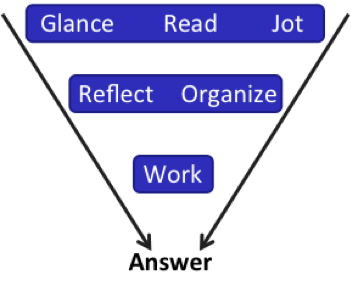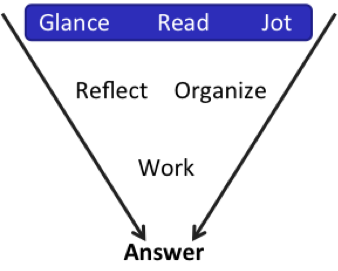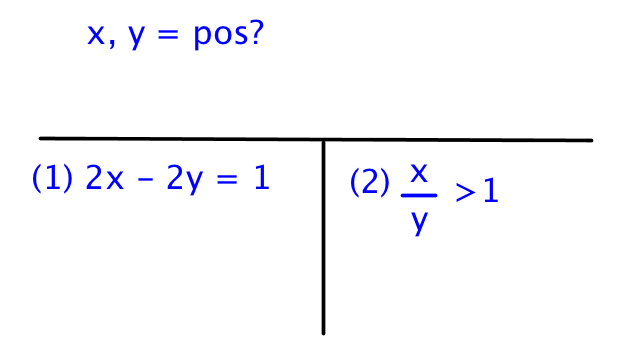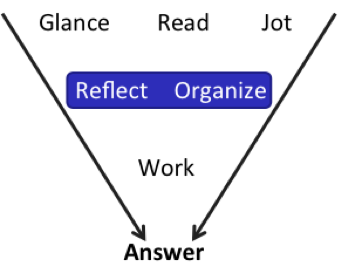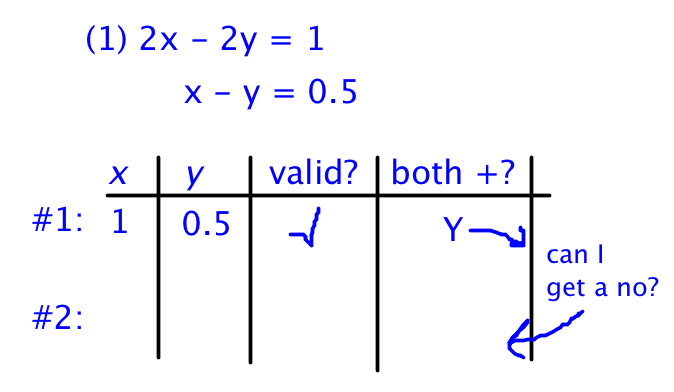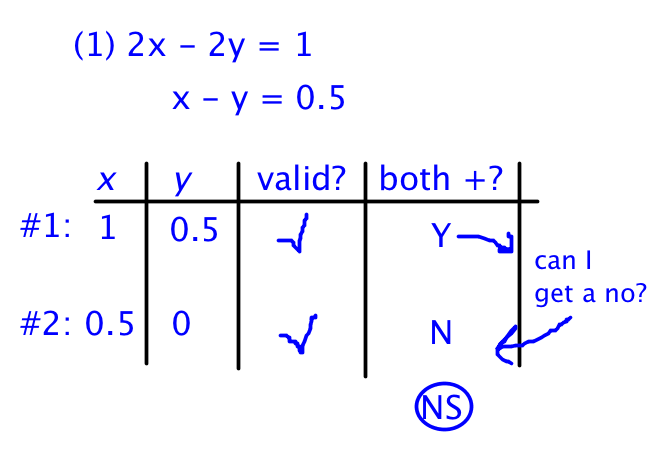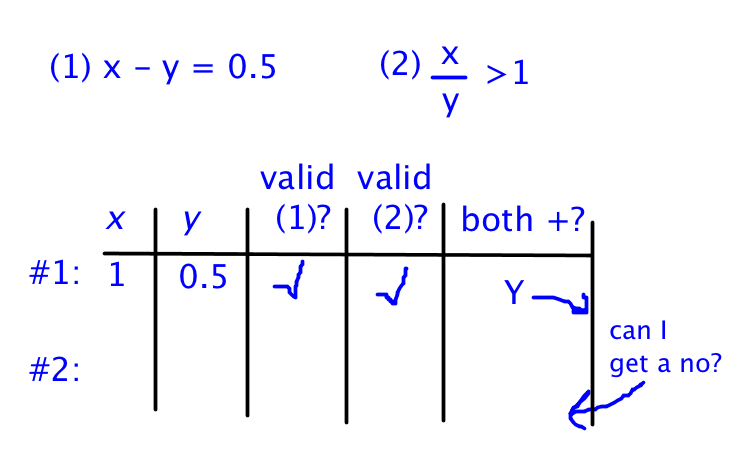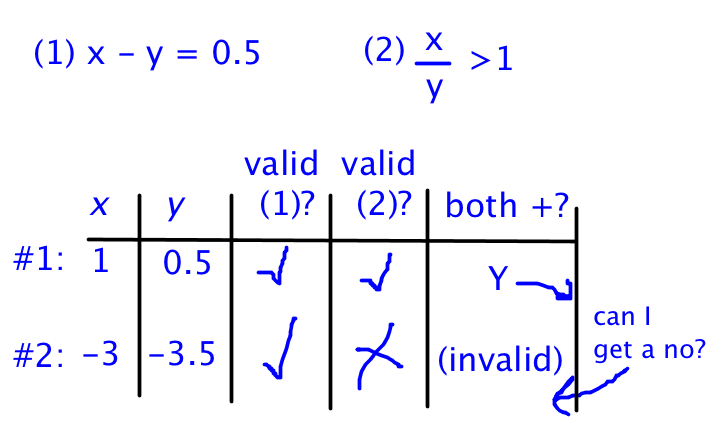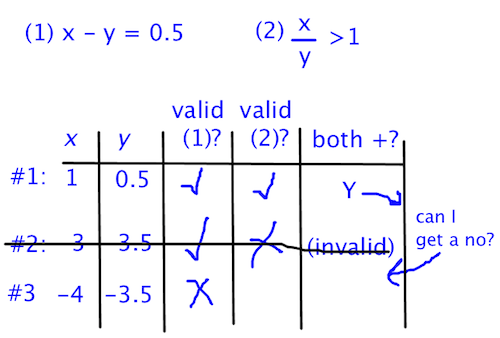-
Target Test Prep 20% Off Flash Sale is on! Code: FLASH20
Redeem
How to Tackle Every Single GMAT Problem (Seriously!) - Part 2
 Last time, I introduced you to a set of principles that tie together everything we need to do on the GMAT.
Last time, I introduced you to a set of principles that tie together everything we need to do on the GMAT.
If you havent already read that article, go ahead and do so now.
Heres our framework again:
Today, were going to try this out on a Data Sufficiency problem.
Try this DS problem from the GMATPrep free exams.
*Are[pmath]x[/pmath] and [pmath]y[/pmath] both positive?(1) [pmath]2x-2y = 1[/pmath]
(2) [pmath]x/y[/pmath]>1
Ready?
Glance: Take about 1-2 seconds to just glance and see what you have.
- Is it PS or DS?
DS. Next:
- Stories / lots of words? Numbers / formulas? Graphics?
Not much going on in the question stem: short and sweet!
- What are the statements like?
An equation and an inequality. Okay.
Finally, you can go ahead and Read this thing. As you read, Jot down the major information.
Note: jot means just that: write down whats there, but do not start solving or manipulating anything yet. Just get everything on your paper.
Time to figure out what this all means.
Whats the significance of asking me whether they are both positive? If they are, they have the same sign. The alternatives are:
- both are +
- one is + and one is
- both are
- one or both are 0
Get those possibilities straight in your head before you start working on this thing and youll be less likely to fall into a trap or make a careless error.
How should I solve this from here? I can solve algebraically / theoretically. I can also test cases (try real numbers to see what works). Nothing theory-wise is jumping out at me from statement (1), so Im going to start by testing some real numbers to see what happens.
Heres statement (1):
(1) [pmath]2x-2y= 1[/pmath]
First, pick any set of values you want that makes this statement valid.
If [pmath]x = 1[/pmath], then hmm, I wonder whether I can make my calculations a little easier here by rearranging that equation:
[pmath]2x-2y = 1[/pmath]
[pmath]2(x-y) = 1[/pmath]
[pmath]x-y = 0.5[/pmath]
Much better. So if [pmath]x = 1[/pmath], then [pmath]y = 0.5[/pmath].
At this stage, I dont think too much about what Im picking; I just find something that does make statement (1) valid. Youll notice that I have a column to test that in my work. I always have this valid? column. If I skip it, Im much more likely to make a careless mistake.
You might also notice a couple of other things. Ive labeled 2 cases from the start, even though Ive only done 1 so far. Again, I always do this to remind myself that I have to try at least 2 different cases when using this strategy.
Next, Ive put a check mark in the valid column, not a Yes. This is crucial! You dont want to mix up the question itself (are both positive?) with checking the validity of the statement. Use a check mark for this step, not a Y/N. (If you discover that your numbers made the statement invalid, cross off the entire row and start again.)
Okay, it turns out that the first numbers I tried made the answer Yes. At this stage of the game, the question is: can I get the opposite answer? Whatever I try first will give me either a Yes or a No for the first set of numbers; for the second set, I actively try to get the opposite answer.
Heres where my early thinking helps me. I want to make one of these numbers negative or 0 and see whether I still have a valid case.
Check it out! A valid case with the opposite answer this time: No. Statement (1) is not sufficient to answer the question. Cross off answers (A) and (D).
Time for statement (2):
(2)[pmath]x/y[/pmath]>1
Hmm. You know what? I dont need to test numbers on this one. I can see that this is testing me on theory.
How? Because Im making a connection to something similar that Ive seen in the past: whats the significance of saying ?
Yeah, theyre telling me that the two signs are the same! Theyre either both positive or both negative. The same is true if [pmath]x/y[/pmath]is greater than 1its still positive. Since thats the case, I cant tell whether theyre both positive, so statement (2) is also not sufficient to answer the question. Eliminate answer (B).
Back to Step 2: Reflect for a second: theres a nagging thought in the back of my head. If all they needed to tell me was that the two have the same sign, then why doesnt statement (2) say >0 instead of >1? Im not going to worry about that right now, since Ive already decided statement (2) is not sufficient, but Im going to remember that as I work through the next step of the problem.
Put the two statements together:
(1)[pmath]2x-2y= 1[/pmath](2)[pmath]x/y[/pmath]>1
Now what? Statement (2) indicates that they have the same sign. Test that concept out in statement (1), either using theory or testing cases.
Theory
Recall the simplified form of statement (1):
[pmath]x-y = 0.5[/pmath]
If both are +: is it possible to have pos pos = 1? Yes. (In fact, I proved this with my first case for the first statement, above.)
If both are : is it possible to have neg neg = 1? Minus a negative is like saying plus a positive. For example: [pmath]-3 - (-10) = -3 + 10[/pmath]. So, yes, its possible for neg neg to equal a positive number, as long as the y value is further from 0 on the number line, or more negative, than the [pmath]x[/pmath]value, so that when the [pmath]y[/pmath]value turns positive, its large enough to make the whole thing positive. In other words, [pmath]y[/pmath]has to be smaller than [pmath]x[/pmath]. (And this makes sense, since the equation can also be written [pmath]x = y + 0.5[/pmath].)
Ah. And heres the issue with statement (2). If , then what else must be true (besides the fact that the two variables have the same sign)? In other words, why did they say that this quotient is greater than 1 and not just greater than 0?
In order for this statement to be true, [pmath]x[/pmath] has to be further from 0 on the number line than [pmath]y[/pmath]. If the two variables are positive, then x has to be bigger than y; for example, [pmath]x = 3[/pmath] and [pmath]y = 1[/pmath] would work.
If the two variables are negative, though, then [pmath]x[/pmath] has to be smaller than [pmath]y[/pmath]; for example, [pmath]x = -3[/pmath] and [pmath]y = -1[/pmath] would work.
But according to statement (1), [pmath]x[/pmath] is greater than [pmath]y[/pmath], so the negative case is invalid. Only the positive case matches, so yes, the two variables are positive.
Testing Cases
Did that theory make your head hurt? You can test cases, instead:
As usual, pick numbers that make the statements validboth statements this time. Youll notice that I first tried the (1, 0.5) pair that I used in statement (1). Try to re-use your work whenever you can. I only had to check that it was valid for statement (2). It was, and the answer to the question is Yes, both are positive.
Okay, can I get a no? Lets see. I cant try the (0.5, 0) pair that I also used for statement (1) because 0 is no longer an option for either variable (it would make the second statement false). So I need to try two negatives. How about:
Wait, that didnt work for statement (2). Hmm, [pmath]x/y[/pmath] has to be > 1, so if both variable are negative, then [pmath]x[/pmath] has to be smaller than [pmath]y[/pmath] (that is, more negative). How about:
Oh wait. That would make [pmath]x-y = -4 - (-3.5) = -0.5[/pmath], not positive 0.5. Wait a second. So, if I want to make them both negative, then according to statement (1), [pmath]x[/pmath] has to be bigger than [pmath]y[/pmath]. BUT, if theyre both negative, then according to statement (2), [pmath]x[/pmath] has to be smaller than [pmath]y[/pmath]. Its impossible for both of those to be true at the same time, so theres no negative pair that will work. The two variables have to be positive.
It turns out that we end up using the theory to help prove whats going on anyway, but testing real numbers allows you to figure out what the theory using practical examples.
The correct answer is (C).
Keep an eye out for this series; I'll be solving another problem tomorrow.
Key Takeaways for Every Problem You Will Ever Do:
(1) First, you have to understand whats in front of you. Glance at the problem to pick up any clues you can about what it is, where the complexity is, and what kinds of strategies might be available to you. As you Read, Jot down the given informationbut dont try to solve yet!
(2) Next, Reflect on what youve been given and Organize your thoughts and your scrap paper. Even though the statement said almost nothing, I still did some valuable thinking that helped me out later on. I also went back and forth between Reflect and Work a couple of times; this is common on DS, when youre constantly having to decide what work you need to do and whether you have enough to make a decision.
(3) Finally, you get to do the Work to solve this thing, jumping back to Reflect whenever needed. For example, I knew that I hadnt figured out the full significance of statement (2) when looking at it by itself, but I also knew enough to know that statement (2) was insufficient, so I just marked the statement as not fully resolved and went on to the next stepwhere, lo and behold, I discovered that I did need to figure out why it said >1, not >0.
* GMATPrep questions courtesy of the Graduate Management Admissions Council. Usage of this question does not imply endorsement by GMAC.
Recent Articles
Archive
- April 2024
- March 2024
- February 2024
- January 2024
- December 2023
- November 2023
- October 2023
- September 2023
- July 2023
- June 2023
- May 2023
- April 2023
- March 2023
- February 2023
- January 2023
- December 2022
- November 2022
- October 2022
- September 2022
- August 2022
- July 2022
- June 2022
- May 2022
- April 2022
- March 2022
- February 2022
- January 2022
- December 2021
- November 2021
- October 2021
- September 2021
- August 2021
- July 2021
- June 2021
- May 2021
- April 2021
- March 2021
- February 2021
- January 2021
- December 2020
- November 2020
- October 2020
- September 2020
- August 2020
- July 2020
- June 2020
- May 2020
- April 2020
- March 2020
- February 2020
- January 2020
- December 2019
- November 2019
- October 2019
- September 2019
- August 2019
- July 2019
- June 2019
- May 2019
- April 2019
- March 2019
- February 2019
- January 2019
- December 2018
- November 2018
- October 2018
- September 2018
- August 2018
- July 2018
- June 2018
- May 2018
- April 2018
- March 2018
- February 2018
- January 2018
- December 2017
- November 2017
- October 2017
- September 2017
- August 2017
- July 2017
- June 2017
- May 2017
- April 2017
- March 2017
- February 2017
- January 2017
- December 2016
- November 2016
- October 2016
- September 2016
- August 2016
- July 2016
- June 2016
- May 2016
- April 2016
- March 2016
- February 2016
- January 2016
- December 2015
- November 2015
- October 2015
- September 2015
- August 2015
- July 2015
- June 2015
- May 2015
- April 2015
- March 2015
- February 2015
- January 2015
- December 2014
- November 2014
- October 2014
- September 2014
- August 2014
- July 2014
- June 2014
- May 2014
- April 2014
- March 2014
- February 2014
- January 2014
- December 2013
- November 2013
- October 2013
- September 2013
- August 2013
- July 2013
- June 2013
- May 2013
- April 2013
- March 2013
- February 2013
- January 2013
- December 2012
- November 2012
- October 2012
- September 2012
- August 2012
- July 2012
- June 2012
- May 2012
- April 2012
- March 2012
- February 2012
- January 2012
- December 2011
- November 2011
- October 2011
- September 2011
- August 2011
- July 2011
- June 2011
- May 2011
- April 2011
- March 2011
- February 2011
- January 2011
- December 2010
- November 2010
- October 2010
- September 2010
- August 2010
- July 2010
- June 2010
- May 2010
- April 2010
- March 2010
- February 2010
- January 2010
- December 2009
- November 2009
- October 2009
- September 2009
- August 2009
